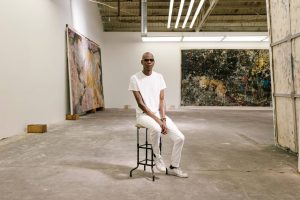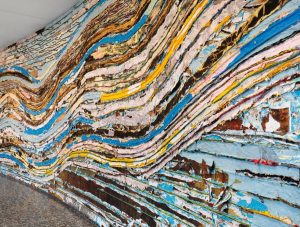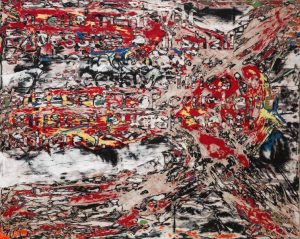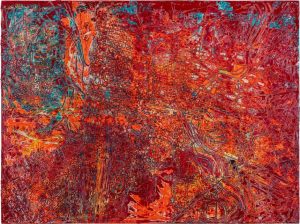Digvijay Nikam
I’m interested in the type of abstraction where you look out at the world, see the horror—sometimes it is horror—and you drag that horror kicking and screaming into your studio and you wrestle with it and you find something beautiful in it.
Mark Bradford
Mark Bradford is an American visual artist highly acclaimed for his large-scale grid-like abstract paintings that combine collage with paint. Born in 1961, Bradford grew up in South Los Angeles

Courtesy of Carmen Chan/ for The Washington Post
and Santa Monica, where his mother ran a beauty salon and did his graduation from the California Institute of the Arts. Bradford has received numerous awards and honours over his career, including his appointment to the American Academy of Arts and Sciences in 2019, the US Department of State’s Medal of Arts in 2014, his appointment as a National Academician in 2013, and a MacArthur Fellowship Award in 2009. He was among the 100 most influential people of 2021 for the TIME magazine.
Bradford’s artistic practice developed out of his initial work at the hair salon lending him his signature style of using end papers – the small, translucent tissue papers used in hairdressing. Since then, he has experimented with other types of paper – often found materials – including maps, billboards, discarded movie posters, comic books, and ‘merchant posters’ that advertise predatory services in economically distressed neighbourhoods. Every material carries emotional weight for him and adds to the message he is trying to convey through a particular piece.
Typically, his process begins by preparing layers and layers of different kinds of papers and cords on a surface which he then carves using techniques like gouging, tearing, shredding, power washing and sanding. The multiple layers create opacity yet the viewer can sense the weight of the layers beneath. His practice also includes sculpture, video, photography, printmaking, and other media.

Courtesy of the artist and Hauser & Wirth
Bradford qualifies his practice as social abstraction – “abstract art with a social or political context clinging to the edges” separating it from that idea of abstraction that involves withdrawing from the world. Characterised by an artistic frenzy in method and composition, Bradford tries to explore the social and political structures that objectify marginalized communities focusing often on specific crises like the AIDS epidemic, Hurricane Katrine, the global housing-market collapse and recently the Covid-19 pandemic and escalating immigration issues. Contestations with the violent history and legacy of racism and homophobia figure consistently in his work invoking US history from the Civil War to the Civil Rights movement as well as the contemporary socio-political battles to ensure equal status for the vulnerable communities.

Courtesy of Smithsonian Institution
Intrigued by the US constitution and the first ten amendments, collectively known as the Bill of Rights, Bradford created a piece titled Amendment #8 trying to complicate our understanding of its reception in the American society using the very material that constitutes the painting, i.e., paper. He talks about how the Bill of Rights and some of the most foundational documents of America are on paper, and yet paper is also something that is shredded and handled frivolously. The contrasting metaphorical and literal legacy of paper as one that is protected is special as well as shredded and compromised is how Bradford wishes to foreground the legacy of the Bill of Rights which the American democracy protects yet often fails to deliver. Even the citizens are unaware of its dense history and political potency which Bradford materialises by creating legibility and illegibility of the words of the Amendment in his paintings.

Courtesy of the artist and Hauser & Wirth.
During the Covid-19 pandemic in 2020, Bradford created a series of three paintings which he exhibited at a publicly inaccessible industrial complex belonging to Hauser and Wirth giving the works an added sense of quarantine. The exhibition titled “Mark Bradford: Quarantine Paintings” was only available for viewing online. The paintings, which were much smaller than his usual scale, are simply titled Q1, Q2, Q3 referring individually to a phase of the pandemic and also a block of time describing what Bradford was feeling when the moment was going on. The vibrant red colour palette of Q1 is a marker of the spreading virus among the gridded space of his city and symbolically the world in the first phase of Covid but simultaneously, a signifier of his agitated and violent disposition while making it, given the unpredictable circumstances in the world.
Bradford’s attempt is not just to create art that talks about the marginalized communities and their concerns but also to help them improve their livelihoods. When he had represented the United States at the 57th Venice Biennale in 2017, he simultaneously launched Process Collettivo, a six-year partnership with the Rio Terà dei Pensieri social cooperative that provides skills training and employment opportunities to incarcerated men and women in and around Venice. In 2014 he also founded Art + Practice, an organisation for promoting free access to museum-curated contemporary art as well as supports the local needs of transition-age foster youth, and children experiencing displacement worldwide through its collaborations with non-profit social service providers.
Currently his work is being exhibited at numerous places including the Rollins Museum of Art, Florida, the Johnson Lowe Gallery, Georgia and Brooklyn Museum of Art, New York.
References
- https://www.forbes.com/sites/tomteicholz/2020/09/27/blood-on-the-canvas-mark-bradford-quarantined/?sh=4c630c311473
- https://www.hauserwirth.com/artists/2838-mark-bradford/
- https://art21.org/artist/mark-bradford/
- https://www.saic.edu/events/mark-bradford
- https://vip-hauserwirth.com/online-exhibitions/mark-bradford-quarantine-paintings/
- https://www.icaboston.org/exhibitions/mark-bradford





